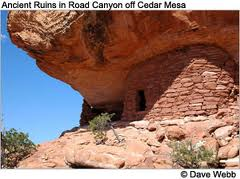
120 archaeologists urge Congress, President to protect the
greater cedar mesa area
Experts in southwest archaeology emphasize the importance of
imperiled cultural resources of Cedar Mesa
Bluff, UT (September 4, 2014) – Today, 120 archaeologists joined the Friends of Cedar Mesa in sending a letter to Utah’s congressional delegation urging the protection of the cultural resources of greater Cedar Mesa by creating a National Conservation Area (NCA). These experts in southwest archaeology, many from Utah, also encouraged President Obama to be prepared to designate a National Monument should Congress fail to act in a timely way to stop the continued loss of American history that has occurred over the last century.
Located in southeastern Utah, the greater Cedar Mesa area is America’s most significant unprotected archaeological area. It is renowned for its impressive rock art panels, well preserved cliff dwellings, pre-historic mesa-top pueblos, and even ancient roads. These sites and the landscape as a whole are considered sacred by several Native American tribes. An analysis of archaeology on Cedar Mesa by the Colorado Plateau Archaeological Alliance called the area “among the richest archaeological districts anywhere in the United States.” For these reasons, the region has been named a National Treasure by the National Trust for Historic Preservation — a historic place where the National Trust has made a long-term commitment to finding a preservation solution.
“I am not surprised by the amount of support protecting Cedar Mesa has in the professional archaeology community,” said William D. Lipe, PhD, Former President of the Society for American Archaeology. “While there are many important archaeological areas in this country that still need protecting, Cedar Mesa is at the top of the list due to the quality of the sites, the beauty of the surrounding landscape, and the richness of the archaeology that’s still there waiting to teach Americans lessons about our past.”
The archaeologists point out the fact Cedar Mesa is one of the most important places in American archaeology, with more than 125 years of research into 12,000 years of American history. Despite the heritage of respectful research, the area has also faced significant looting, grave robbing, and vandalism, which continues at a significant rate today. Dramatic increases in visitation, without resources for public education, also create more challenges for archaeological site preservation.
Several proposals for a National Conservation Area that would protect Cedar Mesa have been presented to Representatives Rob Bishop and Jason Chaffetz through discussion around a larger public lands initiative. Friends of Cedar Mesa and the National Trust for Historic Preservation have presented similar National Conservation Area proposals, encompassing a landscape that is home to more than 56,000 archaeological sites. An NCA would allow for continued ranching, motorized recreation, and cultural site visitation, while also providing greater resources for archaeological protection and public education.
Archaeologists Urge Protection of Cedar Mesa (page 2)
Recognizing their deep connection to these lands, the Navajo Nation and Utah Diné Bikéyah have also proposed a National Conservation Area or a National Monument to protect the greater Cedar Mesa area and additional lands in southeastern Utah to preserve even more cultural sites.
"This land has shaped our culture,” said Utah Dine´ Bike´yah Board Chair Willie Grayeyes. “It is time to protect and restore the lands and bring back traditional Native American stewardship practices for the benefit of all American people."
Friends of Cedar Mesa has been an active participant in a local process in San Juan County that is intended to result in an official proposal from the County to Representatives Bishop and Chaffetz.
“We are excited by the potential to work with our friends and neighbors to provide stewardship of the greater Cedar Mesa via a National Conservation Area,” said Friends of Cedar Mesa Executive Director Josh Ewing. “A NCA can be a very flexible way to protect this landscape, with locally driven management and continuing traditional uses. However, the need for action is urgent, and the American people shouldn’t be willing to let congressional inaction prevent the protection of truly significant and endangered American antiquities.”
Bluff resident Sally Cole has investigated more than 200 sites in the Cedar Mesa area. She observes that the sites retain a strong sense of place and potential for research into the origins and continuities of peoples that lived in the canyons and on the mesa tops for thousands of years. These and thousands of others in the Cedar Mesa area are eligible for listing on the National Register of Historic Places.
“Archaeologists and the public are increasingly aware of the remarkable displays of petroglyphs, rock paintings, and cliff dwelling murals in the Cedar Mesa area,” said Cole, a professional archaeologist and rock art specialist. “These expressions are important for understanding the past—they represent communication systems of ancient and historical Americans and need to be protected and studied through allocation of more resources and proactive management.”
Many of the archaeologists signing the letter attended the Pecos Conference, which was held near Blanding, Utah during August 2014. The Pecos Conference is the longest-running meeting of professional archaeologists in the American Southwest.
A copy of the letter can be found at www.friendsofcedarmesa.org/pecos-letter.